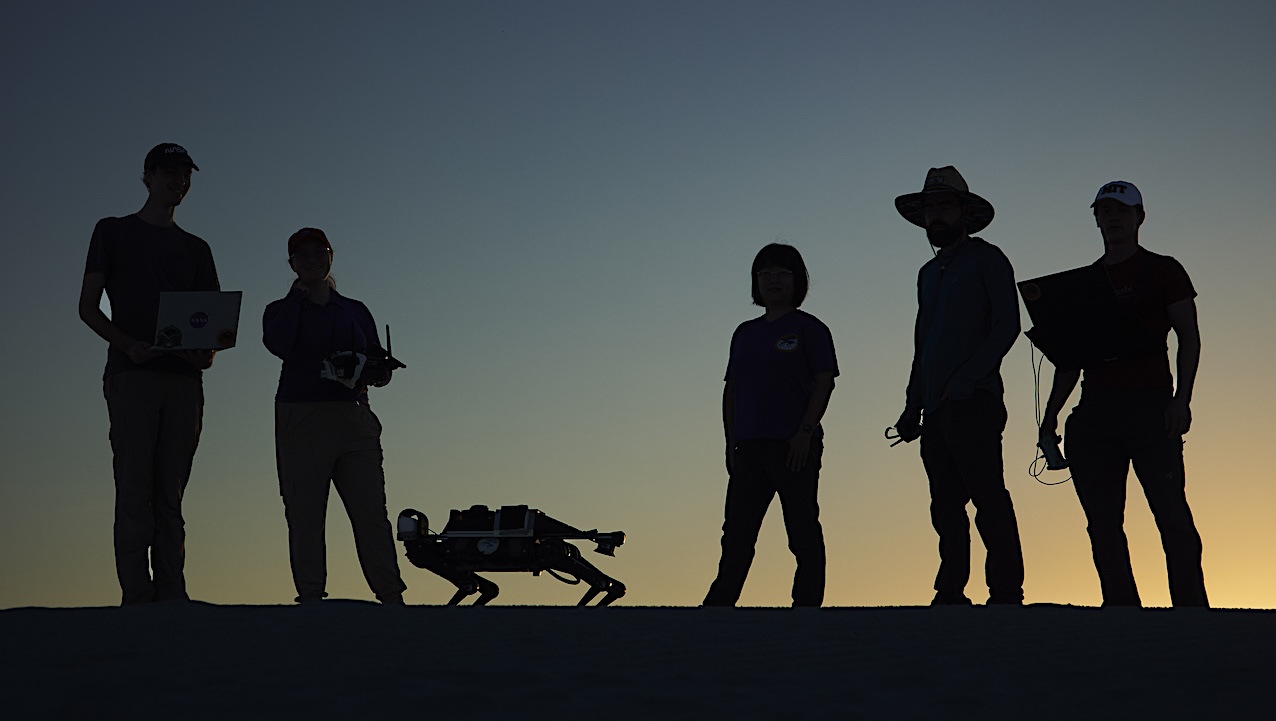Science
Researchers Advance Quadruped Robots for Future Mars Missions

Researchers at various institutions have made significant strides in preparing quadruped robots for scientific exploration on Mars. This month, a team conducted five days of experiments at White Sands National Park in New Mexico, which serves as a simulated environment for the Martian landscape. The experiments aim to enhance the capabilities of these dog-like robots, enabling them to operate effectively alongside astronauts on future missions.
Simulating Martian Conditions
The team focused on developing and testing advanced algorithms that allow quadruped robots to function autonomously. This is a crucial advancement, as it means that these robots can make independent decisions while working alongside human astronauts. Cristina Wilson, a robotics researcher at Oregon State University, highlighted the importance of this capability: “In a scenario where the quadruped would be on the surface of Mars with an astronaut, it would allow both the robot and the astronaut to act independently, increasing the amount of scientific work that could be accomplished.”
This project, part of the LASSIE Project (Legged Autonomous Surface Science in Analog Environments), is funded by NASA as part of its Moon to Mars program. The initiative aims to develop tools for lunar exploration and future crewed missions to Mars, building on previous successes like the deployment of rovers and helicopters on the Martian surface.
Data Collection and Environmental Challenges
During this latest fieldwork, the team collected data from the quadruped robots’ interactions with the sandy terrain, which is essential for understanding how these machines can adapt to different surface conditions. “In the same way that the human foot standing on ground can sense the stability of the surface, legged robots can potentially feel the exact same thing,” Wilson explained. This data will inform future improvements to the robots’ performance on Mars and the Moon.
The environmental conditions at White Sands posed challenges for the research team. High temperatures exceeding 37 degrees Celsius (100 degrees Fahrenheit) forced the team to begin their work at sunrise and conclude by late morning, limiting the time available for testing. Despite these hurdles, the team made notable progress in refining the robots’ algorithms, which led to successful autonomous decision-making for the first time.
In addition, the team experimented with various movement strategies for the robots, aimed at enhancing energy efficiency. Wilson emphasized the ongoing nature of this research, stating, “There is certainly a lot more research to do, but these are important steps in realizing the goal of sending quadrupeds to the Moon and Mars.”
The project team includes experts from several esteemed institutions, such as Texas A&M University, the University of Southern California, the Georgia Institute of Technology, the University of Pennsylvania, and Temple University. Their collaborative efforts are critical in supporting NASA’s broader goals for space exploration.
As the research progresses, the implications for future missions become clearer. The advancements in quadruped robot technology could significantly enhance humanity’s ability to explore and understand the Martian environment, paving the way for long-term exploration and potential colonization.
-

 Technology5 months ago
Technology5 months agoDiscover the Top 10 Calorie Counting Apps of 2025
-

 Technology3 weeks ago
Technology3 weeks agoOpenAI to Implement Age Verification for ChatGPT by December 2025
-

 Health3 months ago
Health3 months agoBella Hadid Shares Health Update After Treatment for Lyme Disease
-

 Health4 months ago
Health4 months agoAnalysts Project Stronger Growth for Apple’s iPhone 17 Lineup
-

 Health4 months ago
Health4 months agoErin Bates Shares Recovery Update Following Sepsis Complications
-

 Technology5 months ago
Technology5 months agoDiscover How to Reverse Image Search Using ChatGPT Effortlessly
-

 Technology3 months ago
Technology3 months agoElectric Moto Influencer Surronster Arrested in Tijuana
-

 Technology5 months ago
Technology5 months agoMeta Initiates $60B AI Data Center Expansion, Starting in Ohio
-

 Technology2 months ago
Technology2 months agoDiscover 2025’s Top GPUs for Exceptional 4K Gaming Performance
-

 Technology5 months ago
Technology5 months agoRecovering a Suspended TikTok Account: A Step-by-Step Guide
-

 Health5 months ago
Health5 months agoTested: Rab Firewall Mountain Jacket Survives Harsh Conditions
-

 Lifestyle5 months ago
Lifestyle5 months agoBelton Family Reunites After Daughter Survives Hill Country Floods




















